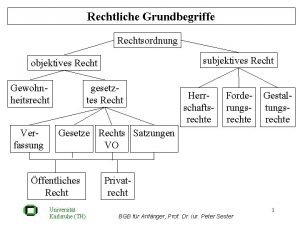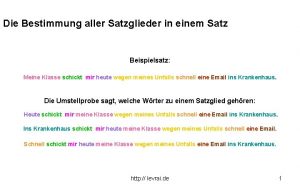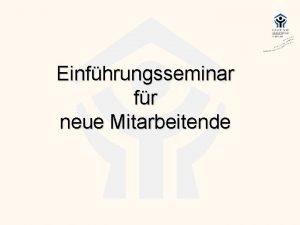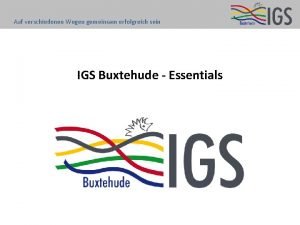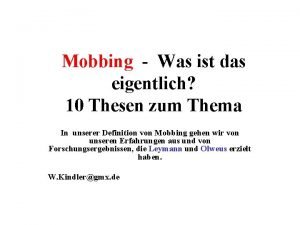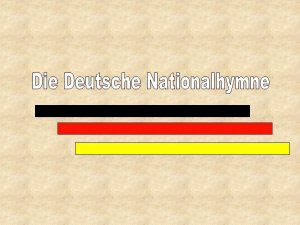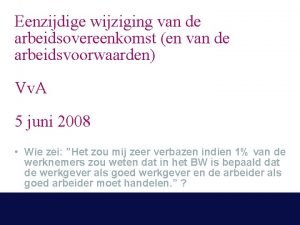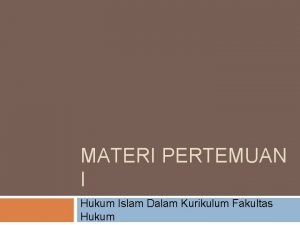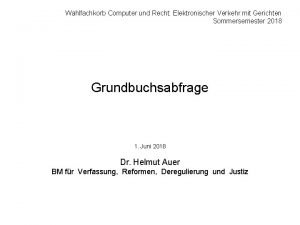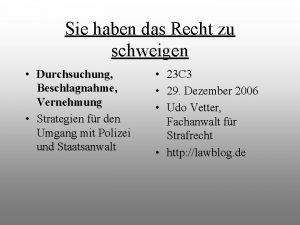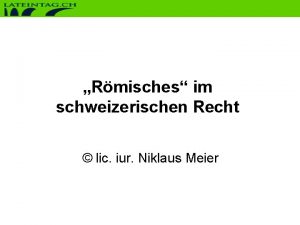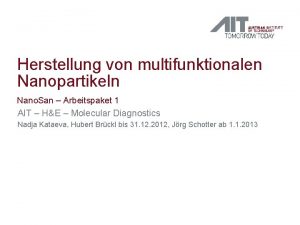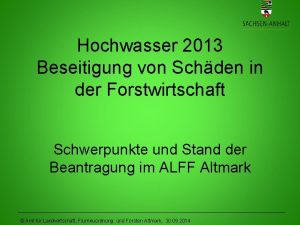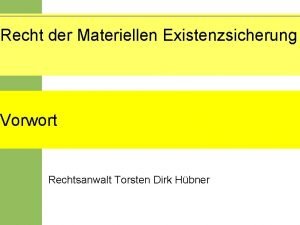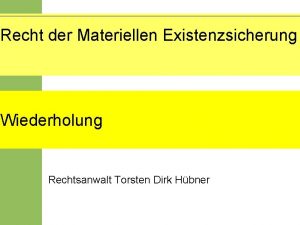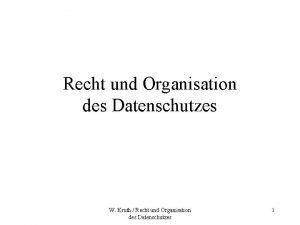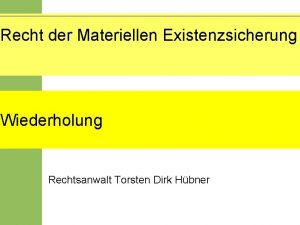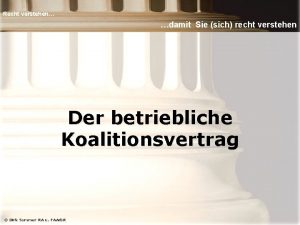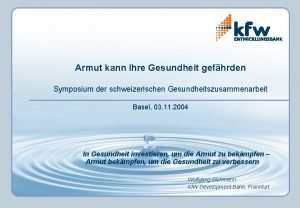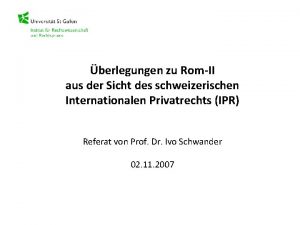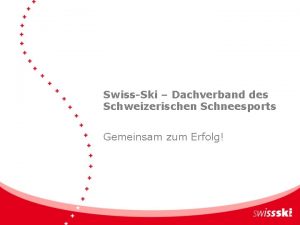Haftung fr Schden wegen Nanopartikeln im schweizerischen Recht


















- Slides: 18

Haftung für Schäden wegen Nanopartikeln im schweizerischen Recht Frédéric Krauskopf Institut für Haftpflicht- und Versicherungsrecht Universität Bern 13. Dezember 2013, Workshop WTI Bern

Von der Herstellung bis zur Entsorgung. . . (Haftung nach schweizerischem Recht) Produktehaftung Delikts -haftung* Entwicklung und Herstellung Verpacken, Transport, Import und Vertrieb Haftung aus Arbeitsvertrag Garantien Arbeitnehmer Garantien Haftung aus Arbeitsvertrag Verkäuferhaftung Inhaber/Konsum Dritte Delikts -haftung* Vertragshaftung Recycling und Entsorgung Haftung aus Arbeitsvertrag Vertragspartner Arbeitnehmer * = alle ausservertragl. Haftungen (z. B. Werkeigentümerhaftung, Haftung für Umweltschäden). 2

Haftungsgrundlagen des schweizerischen Rechts > Vertragshaftung (v. a. Kaufvertrag, Schenkung, Werkvertrag, Miete und Arbeitsvertrag) > Ausservertragliche Haftung (vgl. z. B. Art. 41 ff. OR, Art. 1 ff. Pr. HG, Art. 59 a USG) > Staatshaftung (wird teilweise durch das Privatrecht geregelt: z. B. Art. 58 OR oder Art. 59 Abs. 6 USG) 3

Probleme (zum Ersten) Kausalitätsnachweis Ursache Kausalzusammenhang Erfolg (Schaden) Der Beweis des Kausalzusammenhangs obliegt des geschädigten Partei, welche Schadenersatz fordert. Für den natürlichen Kausalzusammenhang gilt nach der Rechtsprechung das Beweismass der überwiegenden Wahrscheinlichkeit. 4

Probleme (zum Zweiten) Verjährung und Verwirkung Erfolg (Schaden) Ursache Verjährung Vertragliche und ausservertragliche Schadenersatzforderungen, verjähren oder verwirken in der Regel mit Ablauf von 10 Jahren seit der schädigenden Handlung 5

Revision des Verjährungsrechts des schweizerischen Rechts > Parlamentarische Initiativen 2006 (Verlängerung der Verjährungsfristen von Forderung bei Spätschäden) > Hängiges Verfahren vor dem EGMR (Verletzung von Art. 6 EMRK – Recht auf ein faires Verfahren) > Revision des Verjährungsrechts (Gesetzesentwurf vom 29. November 2013) 6

Revision des Verjährungsrechts des schweizerischen Rechts Art. 60 Abs. 1 bis und 2 OR Bei Tötung eines Menschen oder bei Körperverletzung verjährt der Anspruch auf Schadenersatz oder Genugtuung mit Ablauf von drei Jahren von dem Tage an gerechnet, an welchem der Geschädigte Kenntnis vom Schaden und von der Person des Ersatzpflichtigen erlangt hat, jedenfalls aber mit Ablauf von dreissig Jahren, vom Tage an gerechnet, an welchem das schädigende Verhalten erfolgte oder aufhörte. Hat die ersatzpflichtige Person durch ihr schädigendes Verhalten eine strafbare Handlung begangen, so verjährt der Anspruch auf Schadenersatz oder Genugtuung unbeschadet der vorstehenden Absätze frühestens mit Eintritt der strafrechtlichen Verfolgungsverjährung. Tritt diese infolge eines erstinstanzlichen Strafurteils nicht mehr ein, so verjährt der Anspruch frühestens mit Ablauf von drei Jahren seit Eröffnung des Urteils. 7

Revision des Verjährungsrechts des schweizerischen Rechts Art. 128 OR Forderungen auf Schadenersatz oder Genugtuung aus vertragswidriger Körperverletzung oder Tötung eines Menschen verjähren mit Ablauf von drei Jahren vom Tage an gerechnet, an welchem der Geschädigte Kenntnis vom Schaden erlangt hat, jedenfalls aber mit Ablauf von dreissig Jahren, vom Tage an gerechnet, an welchem das schädigende Verhalten erfolgte oder aufhörte. 8

California Code of Civil Procedure 340. 2. (a) In any civil action for injury or illness based upon exposure to asbestos, the time for the commencement of the action shall be the later of the following: (1) Within one year after the date the plaintiff first suffered disability. (2) Within one year after the date the plaintiff either knew, or through the exercise of reasonable diligence should have known, that such disability was caused or contributed to by such exposure. (b) "Disability" as used in subdivision (a) means the loss of time from work as a result of such exposure which precludes the performance of the employee's regular occupation. (c) In an action for the wrongful death of any plaintiff's decedent, based upon exposure to asbestos, the time for commencement of an action shall be the later of the following: (1) Within one year from the date of the death of the plaintiff's decedent. (2) Within one year from the date the plaintiff first knew, or through the exercise of reasonable diligence should have known, that the death was caused or contributed to by such exposure. 9

Liability for Nanomaterials in Swiss Law Frédéric Krauskopf Institute for Liability and Insurance Law University of Bern December 13, 2013, Workshop WTI Bern

Product Lifecycle and Liabilty Product Liability Tort* Remedies Developement and Production Employers' Liability Guarantee Employee Packaging, Import and Distribution Use and Maintenance Third party Tort* Remedies Guarantee Employers' Liability Sellers‘ Liability Contractual Liability Reuse and Disposal Employers' Liability * = all tort remedies (including property owners‘ liability and environmental liability). Cocontractor Employee 11

Liability Principles > Contractual liability (e. g. sales contract, contract for work and services, lease and employment contract) > Tort remedies (e. g. art. 41 et seqq. Swiss Code of Obligations, art. 59 a Swiss Environmental Protection Act, art. 1 et seqq. Swiss Product Liability Act) > State liability (e. g. art. 58 Swiss Code of Obligations and art. 59 para. 6 Swiss Environmental Protection Act) 12

Problems Evidence proving causality Cause Causality Effect (Damage) The burden of proof of causality between defendant‘s conduct and an alleged damage lies with the damaged party who demands compensation. Swiss courts award compensation only if the plaintiff proves that his loss or damage was, on the overwhelming balance of probabilities, caused by an act committed by the defendant. 13

Problems Statute of Limitations and Forfeiture Cause 0 1 2 Damage 3 4 5 6 7 8 9 10 11 Statute of Limitations 12 13. . . With a few exceptions, all claims for damages or compensation for pain and suffering become barred by statute of limitations or forfeiture at the latest ten years after the date on which the loss or damage was caused. 14

Swiss Statute of Limitations > Two Initiatives in Parliament in 2006 (Extension of the statute of limation in case of long-term damages) > Pending case before the European Court of Human Rights (Violation of art. 6 ECHR – Right to a fair trial) > Amendment (Draft law, November 29, 2013) 15

Amendment Swiss Code of Obligations Art. 60 Abs. 1 bis and 2 CO In the event of personal injury or death, claims for damages and compensation for pain and suffering become time-barred three years from the date on which the injured party became aware of the loss or damage and of the identity of the person liable for it but in any event thirty years after the date on which the damaging act occurred or ended. If the damaging act of the liable person is criminal offence for which criminal law envisages a longer period of limitation of prosecution, that longer period also applies to the civil law claim. If a judgment is issued by a court of first instance before the expiry of the limitation period, the prescription of the civil law claim occurs et the earliest three years consequent upon the issue of the judgment. 16

Amendment Swiss Code of Obligations Art. 128 OR Claims for damages or compensation for pain and suffering by reason of personal injury or death which arose from a breach of contract become time-barred one year from the date on which the injured party became aware of the loss or damage but in any event thirty years after the date on which the damaging act occurred or ended. 17

California Code of Civil Procedure 340. 2. (a) In any civil action for injury or illness based upon exposure to asbestos, the time for the commencement of the action shall be the later of the following: (1) Within one year after the date the plaintiff first suffered disability. (2) Within one year after the date the plaintiff either knew, or through the exercise of reasonable diligence should have known, that such disability was caused or contributed to by such exposure. (b) "Disability" as used in subdivision (a) means the loss of time from work as a result of such exposure which precludes the performance of the employee's regular occupation. (c) In an action for the wrongful death of any plaintiff's decedent, based upon exposure to asbestos, the time for commencement of an action shall be the later of the following: (1) Within one year from the date of the death of the plaintiff's decedent. (2) Within one year from the date the plaintiff first knew, or through the exercise of reasonable diligence should have known, that the death was caused or contributed to by such exposure. 18
 öffentliches recht
öffentliches recht Satzglieder bestimmung
Satzglieder bestimmung Mutterschutz
Mutterschutz Igs buxtehude lehrer
Igs buxtehude lehrer Sushi lyrics von wegen lisbeth
Sushi lyrics von wegen lisbeth Auf verschiedenen wegen
Auf verschiedenen wegen Bouwklasse wegen
Bouwklasse wegen Mobbing präsentation
Mobbing präsentation Trotz + genitiv beispiel
Trotz + genitiv beispiel Subsumieren recht
Subsumieren recht Einigkeit und recht und freiheit text
Einigkeit und recht und freiheit text Verworven recht arbeidstijden
Verworven recht arbeidstijden Praktisch burgerlijk recht
Praktisch burgerlijk recht Universität bern rechtswissenschaften
Universität bern rechtswissenschaften Mohammedaansch recht
Mohammedaansch recht Wahlfachkorb computer und recht
Wahlfachkorb computer und recht Mp bürgerliches recht prüfer
Mp bürgerliches recht prüfer Dubbelstudie recht en economie
Dubbelstudie recht en economie Sie haben das recht zu schweigen
Sie haben das recht zu schweigen
